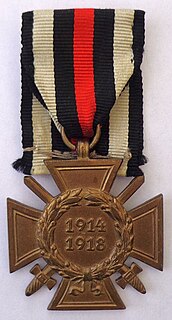Awards and Decorations of Nazi Germany were military, political and civilian decorations that were bestowed between 1923 and 1945, first by the Nazi Party and later the state of Nazi Germany.

The cuff title is a form of commemorative or affiliation insignia placed on the sleeve, near the cuff, of German military and paramilitary uniforms. The tradition can be traced back to the foundation of the "Gibraltar" band, which was authorised in 1783 by King George III for regiments of the Electorate of Hanover.
Friedrich Materna was a general in the Bundesheer in the 1930s and the German Wehrmacht during the World War II.

The Honour Cross of the World War 1914/1918, commonly, but incorrectly, known as the Hindenburg Cross or the German WWI Service Cross was established by Field Marshal Paul von Hindenburg, President of the German Weimar Republic, by an order dated 13 July 1934, to commemorate service of the German people during the First World War. This was Germany's first official service medal for soldiers of Imperial Germany who had taken part in the war, and where they had since died it was also awarded to their surviving next-of-kin. Shortly after its issuance, the government of Nazi Germany declared the award as the only official service decoration of the First World War and further forbade the continued wearing of German Free Corps awards on any military or paramilitary uniform of a state or Nazi Party organization.

The Close Combat Clasp was a World War II German military award instituted on 25 November 1942 for participation in hand-to-hand fighting at close quarters. Intended primarily for infantry, other Wehrmacht, Waffen-SS, ground Luftwaffe units and paratroopers were also eligible.

The German Armed Forces Deployment Medal is a decoration of the Bundeswehr, the armed forces of the Federal Republic of Germany. The decoration is awarded for military service in a designated military campaign. It is awarded to all German soldiers regardless of rank. It is also the only type of German campaign medal awarded, the only difference is the campaign bar worn on the medal and ribbon.
The honours system in the Republic of Austria is a means of rewarding individuals' personal achievement, or service to Austria by state decorations and medals.

The Minesweeper War Badge or Minesweepers, Sub-Chasers and Escort-Vessel War Badge was a World War II German military decoration awarded to Kriegsmarine members for service on minesweepers vessels. The award was instituted on 31 August 1940 by Grand Admiral Erich Raeder. It was first awarded on 28 November 1940.
The Austrian Sports Badge is a decoration presented for physical fitness by the Republic of Austria.

The Medal for Exemplary Border Service was a national award issued in the German Democratic Republic (GDR). It was established on 28 May 1954, by the Council of Ministers of the GDR with Order No. 47/54 from the Ministry of Interior on 16 June 1954. The first presentation ceremony took place on 1 July 1954, to members of the German Border Police.
The Austrian Armed Forces Operations Medal was established in 2001 to recognize operational service by the Military of Austria. The medal is 40 mm wide and round, suspended from a ribbon that varies depending on the type of operation.

The Military Service Medal German: Wehrdienstmedaille is a military medal awarded to members of the Military of Austria. It is awarded in three classes: gold, silver, and bronze depending on length of recognized service. Established in 1963, the medal was originally called the Military Commemorative Service Medal (Wehrdiensterinnerungsmedaille). The name was changed to its current name in 1989.

The German Flood Service Medal 2013 is a military and civil award of Germany. Established 2 July 2013 by joint decree of the Federal Minister of the Interior Hans-Peter Friedrich and Federal Minister of Defence Thomas de Maizière, the medal is awarded for approved service during the 2013 European floods. It was approved by the President of Germany on 23 October 2013.

The Mine Rescue Decoration is a state award of the Republic of Austria, established on February 24, 1954 by the National Council. The award is presented by the Federal Ministry of Trade and Reconstruction, currently known as the Ministry of Digital and Economic Affairs, to both members and non-members of the mine rescue services.
The Military Recognition Medal is a military decoration of the Republic of Austria. Established in 2006, the medal may be awarded to members of the military or civilians for service to the Austrian Armed Forces.
The Decoration of the Federal Agency for Technical Relief is a German decoration founded in 1975. It is awarded by the Technisches Hilfswerk (THW) and is approved by the President of Germany.
The Metz 1944 Cuff Title, or Metz 1944 Cuff Band, was a World War II German military decoration instituted to reward members of the Wehrmacht who took part in the 1944 battle of Metz.

The Warsaw Shield,, or Warsaw Arm Shield, was a planned World War II German military decoration intended for award to Wehrmacht and Waffen-SS servicemen who took part in the suppression of the 1944 Warsaw uprising. Although authorised, with the conditions of award and the design approved and announced, production had not begun prior to the end of the war and the award was never issued.

The Battle of Herkulesfürdő was a military engagement during the Romanian Campaign of World War I. It was fought between Romanian forces on one side and Central Powers forces on the other side. It resulted in a Romanian victory.
The First Battle of Orsova was a World War I military engagement between Austro-Hungarian and German forces on one side and Romanian forces on the other side. The Central Powers failed to advance, the battle thus resulting in a Romanian victory.











